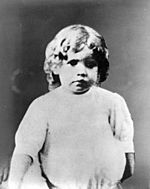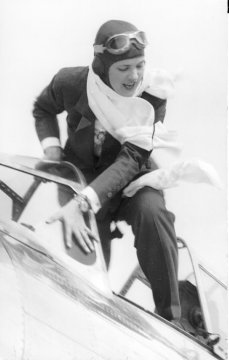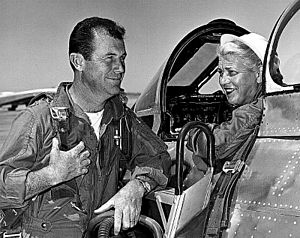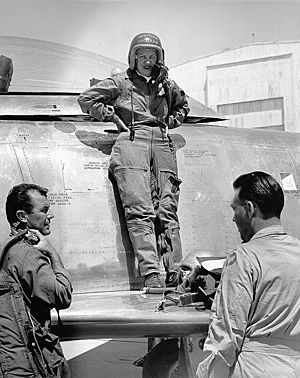Jacqueline Cochran facts for kids
Quick facts for kids
Jacqueline Cochran
|
|
|---|---|
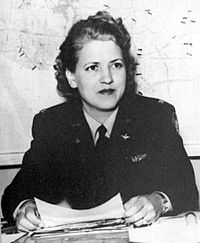
Jacqueline Cochran c. 1943
|
|
| Born | May 11, 1906 Pensacola, Florida, U.S.
|
| Died | August 9, 1980 (aged 74) Indio, California, U.S.
|
| Occupation | aviator, test pilot, spokesperson, and businessperson |
| Spouse(s) | Jack Cochran Floyd Bostwick Odlum |
| Military career | |
| Allegiance | United States |
| Service/ |
Women Airforce Service Pilots Air Force Reserve Command |
| Years of service | 1942–1970 |
| Rank | Colonel |
| Awards | Distinguished Service Medal Distinguished Flying Cross |
Jacqueline Cochran (May 11, 1906 – August 9, 1980) was an American pilot and business executive. She pioneered women's aviation as one of the most prominent racing pilots of her generation. She set numerous records and was the first woman to break the sound barrier on 18 May 1953. Cochran was the wartime head of the Women Airforce Service Pilots (WASP) (1943–44), (along with Nancy Love) which employed about 1000 civilian American women in a non-combat role to ferry planes from factories to port cities.
Contents
Early life
Jacqueline Cochran, born Bessie Lee Pittman, in Pensacola, (some sources indicate she was born in DeFuniak Springs) in the Florida Panhandle, was the youngest of the five children of Mary (Grant) and Ira Pittman, a skilled millwright who frequently relocated setting up and reworking sawmills. While her family was not wealthy, Cochran's childhood living in small-town Florida was similar to those in other families of the era. Contrary to some accounts, there was always food on the table and she was not adopted, as she often claimed.
Circa 1920, (she would have been 13 or 14), she married Robert Cochran and gave birth to a son, Robert, who died in 1925 at the age of 5. After the marriage ended, she kept the name Cochran and began using Jacqueline or Jackie as her given name. Cochran then became a hairdresser and got a job in Pensacola, eventually moving to New York City. There, she used her looks and driving personality to get a job at a prestigious salon at Saks Fifth Avenue.
Although Cochran denied her family and her past, she remained in touch with them and provided for them over the years. Some of her family moved to her ranch in California after she remarried. They were instructed to always say they were her adopted family. Cochran apparently wanted to hide from the public the early chapters of her life and was successful in doing so until after her death.
Later Cochran met Floyd Bostwick Odlum, founder of Atlas Corp. and CEO of RKO in Hollywood. Fourteen years her senior, he was reputed to be one of the 10 wealthiest men in the world. Odlum became enamored of Cochran and offered to help her establish a cosmetics business.
After a friend offered her a ride in an aircraft, Cochran began taking flying lessons at Roosevelt Airfield, Long Island in the early 1930s and learned to fly an aircraft in three weeks. She then soloed and within two years obtained her commercial pilot's license. Odlum, whom she married in 1936 after his divorce, was an astute financier and savvy marketer who recognized the value of publicity for her business. Calling her line of cosmetics Wings to Beauty, she flew her own aircraft around the country promoting her products. Years later, Odlum used his Hollywood connections to get Marilyn Monroe to endorse Cochran's line of lipstick.
Contributions to aviation
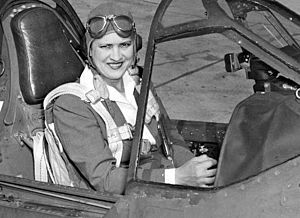
Known by her friends as "Jackie", and maintaining the Cochran name, she was one of three women to compete in the MacRobertson Air Race in 1934. In 1937, she was the only woman to compete in the Bendix race and worked with Amelia Earhart to open the race to women. That year, she also set a new women's world speed record. By 1938, she was considered the best female pilot in the United States. She had won the Bendix and set a new transcontinental speed record as well as altitude records. Cochran was the first woman to fly a bomber across the Atlantic. She won five Harmon Trophies. Sometimes called the "Speed Queen", at the time of her death, no other pilot held more speed, distance, or altitude records in aviation history than Cochran.
Ninety-Nines
Cochran was a friend of Amelia Earhart. Although she was not a founding member of the Ninety-Nines, she was one of their most influential members. She was president of the Ninety-Nines from 1941-1943, and was instrumental in ensuring that women pilots would be able to participate in the newly-founded Civil Air Patrol as well as the WASP. In her monthly editorials for the Ninety-Nines Newsletter, she exhorted members to join the CAP or the WASP, and to do what they could to help the war effort.
Air Transport Auxiliary
Before the United States joined World War II, Cochran was part of "Wings for Britain", an organization that ferried American-built aircraft to Britain, becoming the first woman to fly a bomber (a Lockheed Hudson V) across the Atlantic. In Britain, she volunteered her services to the Royal Air Force. For several months she worked for the British Air Transport Auxiliary (ATA), recruiting qualified women pilots in the United States and taking them to England where they joined the ATA. Cochran attained the rank of Flight Captain (equivalent to a Squadron Leader in the RAF or a Major in the U.S. Air Force) in the ATA.
Women Airforce Service Pilots
In September, 1939, Cochran wrote to Eleanor Roosevelt to introduce the proposal of starting a women's flying division in the Army Air Forces. She felt that qualified women pilots could do all of the domestic, noncombat aviation jobs necessary to release more male pilots for combat. She pictured herself in command of these women, with the same standings as Colonel Oveta Culp Hobby, who was then the director of the Women's Army Auxiliary Corps (WAAC). (The WAAC was given full military status on July 1, 1943, thus making them part of the Army. At the same time, the unit was renamed Women's Army Corps (WAC).)
That same year, Cochran wrote a letter to Lieutenant Colonel Robert Olds, who was helping to organize the Air Corps Ferrying Command for the Air Corps at the time. (Ferrying Command was originally a courier/aircraft delivery service, but evolved into the air transport branch of the United States Army Air Forces (USAAF) as the Air Transport Command). In the letter, Cochran suggested that women pilots be employed to fly non-combat missions for the new command. In early 1941, Olds asked Cochran to find out how many women pilots there were in the United States, what their flying times were, their skills, their interest in flying for the country, and personal information about them. She used records from the Civil Aeronautics Administration to gather the data.
In spite of pilot shortages, Lieutenant General Henry H. "Hap" Arnold was the person who needed to be convinced that women pilots were the solution to his staffing problems. Arnold, Chief of the Air Corps, continued as commanding general of the Army Air Forces upon its creation in June 1941. He knew that women were being used successfully in the ATA in England so Arnold suggested that Cochran take a group of qualified female pilots to see how the British were doing. He promised her that no decisions regarding women flying for the USAAF would be made until she returned.
When Arnold asked Cochran to go to Britain to study the ATA, Cochran asked 76 of the most qualified female pilots – identified during the research she had done earlier for Olds – to come along and fly for the ATA. Qualifications for these women were high: at least 300 hours of flying time, but most of the women pilots had over 1,000 hours. Those who made it to Canada found out that the washout rate was also high. A total of 25 women passed the tests and, two months later in March 1942 they went to Britain with Cochran to join the ATA.
While Cochran was in England, in September 1942, General Arnold authorized the formation of the Women's Auxiliary Ferrying Squadron (WAFS) under the direction of Nancy Harkness Love. The WAFS began at New Castle Air Base in Wilmington, Delaware, with a group of female pilots whose objective was to ferry military aircraft. Hearing about the WAFS, Cochran immediately returned from England. Cochran's experience in Britain with the ATA convinced her that women pilots could be trained to do much more than ferrying. Lobbying Arnold for expanded flying opportunities for female pilots, he sanctioned the creation of the Women's Flying Training Detachment (WFTD), headed by Cochran. In August 1943, the WAFS and the WFTD merged to create the Women Airforce Service Pilots (WASP) with Cochran as director and Nancy Love as head of the ferrying division.
As director of the WASP, Cochran supervised the training of hundreds of women pilots at the former Avenger Field in Sweetwater, Texas from August 1943 to December 1944.
Award of the Distinguished Service Medal
For her wartime service, she received the Distinguished Service Medal (DSM) in 1945. Her award of the DSM was announced in a War Department press release dated March 1, 1945 which stated that Cochran was the first woman civilian to receive the DSM, which was then the highest non-combat award presented by the United States government. (In actuality, however, a few civilian women received the DSM for service during the First World War. These women included Hannah J. Patterson and Anna Howard Shaw of the Council of National Defense, Evangeline Booth of the Salvation Army as well as Mary V. Andress and Jane A. Delano of the American Red Cross.)
Postwar
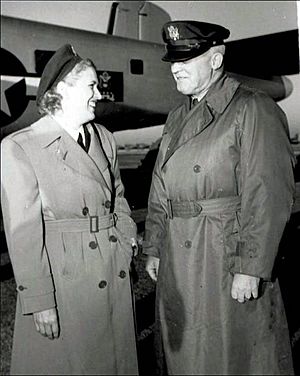
At war's end, Cochran was hired by a magazine to report on global postwar events. In this role, she witnessed Japanese General Tomoyuki Yamashita's surrender in the Philippines and was then the first non-Japanese woman to enter Japan after the War and attended the Nuremberg Trials in Germany.
On September 9, 1948, Cochran joined the U.S. Air Force Reserve as a lieutenant colonel. She was promoted to colonel in 1969 and retired in 1970. She was, quite probably, the first woman pilot in the United States Air Force. During her career in the Air Force Reserve, she received three awards of the Distinguished Flying Cross for various achievements from 1947 to 1964.
Flying records
Postwar, Cochran began flying the new jet aircraft, setting numerous records. She became the first woman pilot to "go supersonic".
In 1952, Cochran, at age 47, decided to challenge the world speed record for women, then held by Jacqueline Auriol. She tried to borrow an F-86 from the U.S. Air Force, but was refused. She was introduced to an Air Vice-Marshal of the Royal Canadian Air Force (RCAF) who, with the permission of the Canadian Minister of Defence, arranged for her to borrow 19200, the sole Sabre 3. Canadair sent a 16-man support team to California for the attempt. On 18 May 1953, Cochran set a new 100 km speed record of 1,050.15 km/h (652.5 mph). Later on 3 June, she set a new 15 km closed circuit record of 1078 km/h (670 mph). Encouraged by then-Major Chuck Yeager, with whom Cochran shared a lifelong friendship, on May 18, 1953, at Rogers Dry Lake, California, Cochran flew the Sabre 3 at an average speed of 652.337 mph. During the course of this run the Sabre went supersonic, and Cochran became the first woman to break the sound barrier.
Among her many record accomplishments, from August to October 1961, as a consultant to Northrop Corporation, Cochran set a series of speed, distance and altitude records while flying a Northrop T-38A-30-NO Talon supersonic trainer, serial number 60-0551. On the final day of the record series, she set two Fédération Aéronautique Internationale (FAI) world records, taking the T-38 to altitudes of 55,252.625 feet (16,841 m) in horizontal flight and reaching a peak altitude of 56,072.835 feet (17,091 m).
Cochran was also the first woman to land and take off from an aircraft carrier, the first woman to pilot a bomber across the North Atlantic (in 1941) and later to fly a jet aircraft on a transatlantic flight, the first woman to make a blind (instrument) landing, the only woman ever to be president of the Fédération Aéronautique Internationale (1958–1961), the first woman to fly a fixed-wing, jet aircraft across the Atlantic, the first pilot to fly above 20,000 feet (6,096 m) with an oxygen mask, and the first woman to enter the Bendix Transcontinental Race. She still holds more distance and speed records than any pilot living or dead, male or female.
Because of her interest in all forms of aviation, Cochran flew the Goodyear Blimp in the early 1960s with Goodyear Blimp Captain R. W. Crosier in Akron, Ohio.
Mercury 13
In the 1960s, Cochran was a sponsor of the Mercury 13 program, an early effort to test the ability of women to be astronauts. Thirteen women pilots passed the same preliminary tests as the male astronauts of the Mercury program before the program was cancelled. It was never a NASA initiative, though it was spearheaded by two members of the NASA Life Sciences Committee, one of whom, William Randolph Lovelace II, was a close friend of Cochran and her husband. Though Cochran initially supported the program, she was later responsible for delaying further phases of testing, and letters from her to members of the Navy and NASA expressing concern over whether the program was to be run properly and in accordance with NASA goals may have significantly contributed to the eventual cancellation of the program. It is generally accepted that Cochran turned against the program out of concern that she would no longer be the most prominent female aviator.
On 17 and 18 July 1962, Representative Victor Anfuso (D-NY) convened public hearings before a special Subcommittee of the House Committee on Science and Astronautics to determine whether or not the exclusion of women from the astronaut program was discriminatory, during which John Glenn and Scott Carpenter testified against admitting women to the astronaut program. Cochran herself argued against bringing women into the space program, saying that time was of the essence, and moving forward as planned was the only way to beat the Soviets in the Space Race. (None of the women who had passed the tests were military jet test pilots, nor did they have engineering degrees, which were the two basic experiential qualifications for potential astronauts. Women were not allowed to be military jet test pilots at that time. On average, however, they all had more flight experience than the male astronauts.) "NASA required all astronauts to be graduates of military jet test piloting programs and have engineering degrees. In 1962, no women could meet these requirements." This ended the Mercury 13 program. However, John Glenn and Scott Carpenter, who were part of the Mercury 7, also did not have engineering degrees when they were selected. Both of them were granted a degree after their flights for NASA.
Significantly, the hearings investigated the possibility of gender discrimination a two full years before the Civil Rights Act of 1964 made that illegal, making these hearings a marker of how ideas about women's rights permeated political discourse even before they were enshrined in law.
Political activities
A lifelong Republican, Cochran, as a result of her involvement in politics and the military, became close friends with General Dwight Eisenhower. In the early part of 1952, she and her husband helped sponsor a large rally at Madison Square Garden in New York City in support of an Eisenhower presidential candidacy.
The rally was documented on film and Cochran personally flew it to France for a special showing at Eisenhower's headquarters. Her efforts proved a major factor in convincing Eisenhower to run for President of the United States in 1952 and she played a major role in his successful campaign. Close friends thereafter, Eisenhower frequently visited her and her husband at their California ranch and after leaving office, wrote portions of his memoirs there.
Politically ambitious, Cochran ran for Congress in 1956 from California's 29th Congressional District as the candidate of the Republican Party. Her name appeared throughout the campaign and on the ballot as Jacqueline Cochran-Odlum. Although she defeated a field of five male opponents to win the Republican nomination, in the general election she lost a close election to Democratic candidate and first Asian-American congressman Dalip Singh Saund. Saund won with 54,989 votes (51.5%) to Cochran's 51,690 votes (48.5%). Her political setback was one of the few failures she ever experienced and she never attempted another run. Those who knew Cochran have said that the loss bothered her for the rest of her life.
Legacy
Cochran died on August 9, 1980 at her home in Indio, California that she shared with her husband until he had died four years prior. She was a long-time resident of the Coachella Valley and is buried in Coachella Valley Public Cemetery. She regularly utilized Thermal Airport over the course of her long aviation career. The airport, which had been renamed Desert Resorts Regional, was again renamed Jacqueline Cochran Regional Airport in her honor.
Cochran's aviation accomplishments never gained the continuing media attention given those of Amelia Earhart. Also, Cochran's use of her husband's immense wealth reduced the rags-to-riches nature of her story. Nonetheless, she deserves a place in the ranks of famous women aviators and as a woman who frequently used her influence to advance the cause of women in aviation.
Despite her lack of formal education, Cochran had a quick mind and an affinity for business and her investment in the cosmetics field proved a lucrative one. Later, in 1951, the Boston Chamber of Commerce voted her one of the 25 outstanding businesswomen in America. In 1953 and 1954, the Associated Press named her "Woman of the Year in Business".
Cochran served on the Board of Trustees for the George Washington University from 1962 until her passing in 1980.
Blessed by fame and wealth, Cochran donated a great deal of time and money to charitable works.
Military awards
|
|
|||||||||||||||
Other awards

From many countries around the world, Cochran received citations and awards. In 1949, the government of France recognized her contribution to the war and aviation awarding her in 1951 with the French Air Medal. She is the only woman to ever receive the Gold Medal from the Fédération Aéronautique Internationale. She went on to be elected to that body's board of directors and director of Northwest Airlines in the U.S. At home, the Air Force awarded her the Distinguished Flying Cross and the Legion of Merit. In 1949, Cochran became the fourth U.S. recipient of the Türk Hava Kurumu's (Turkish Aeronautical Association) highest award, the Murassa Brövesi (Diamond Brevet).
An annual air show called the Jacqueline Cochran Air Show is named in her honor and takes place at the Jacqueline Cochran Regional Airport. Cochran also became the first woman to be honored with a permanent display of her achievements at the United States Air Force Academy. In the play The Fastest Woman Alive, written by Karen Sunde, Cochran's life is chronicled alongside her husband, Floyd, Amelia Earhart, and others.
Other honors include:
- 1964, received the Golden Plate Award of the American Academy of Achievement
- 1965, induction into the International Aerospace Hall of Fame
- 1971, induction into the National Aviation Hall of Fame
- 1985, the International Astronomical Union assigned the name Cochran to a large (100 km in diameter) crater on planet Venus
- 1992, induction into the Florida Women's Hall of Fame
- 1993, induction into the Motorsports Hall of Fame of America
- 1993, induction into the National Women's Hall of Fame.
- 1996, the United States Post Office honored Cochran with a 50¢ postage stamp, depicting her in front of a Bendix Trophy pylon with her P-35 in the background and the words: "Jacqueline Cochran Pioneer Pilot"
- 2002, induction into the Georgia Aviation Hall of Fame.
- 2006, induction into the Lancaster, California Aerospace Walk of Honor as its first woman inductee
See also
 In Spanish: Jacqueline Cochran para niños
In Spanish: Jacqueline Cochran para niños


